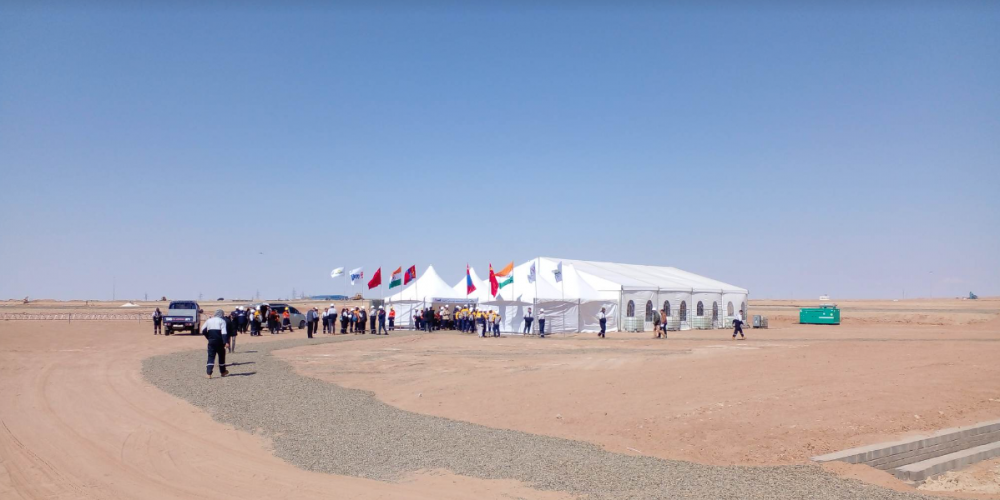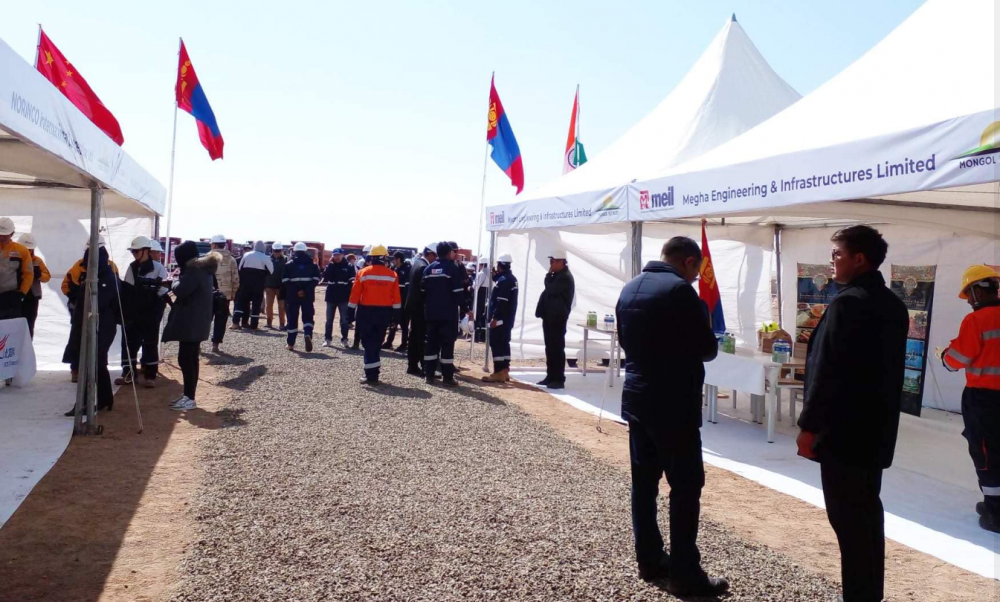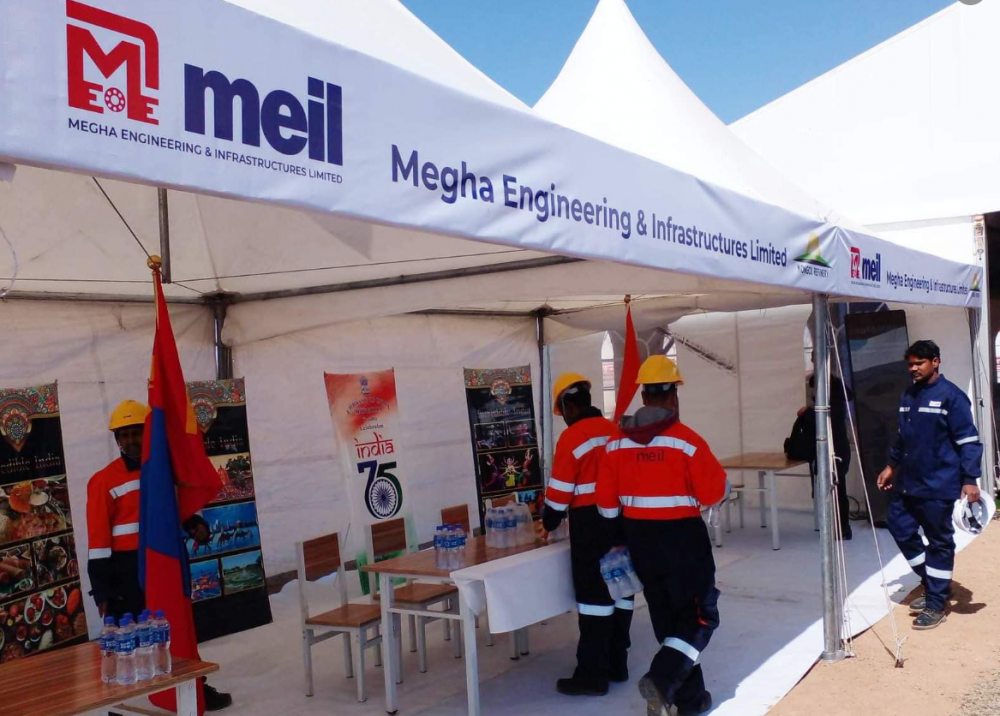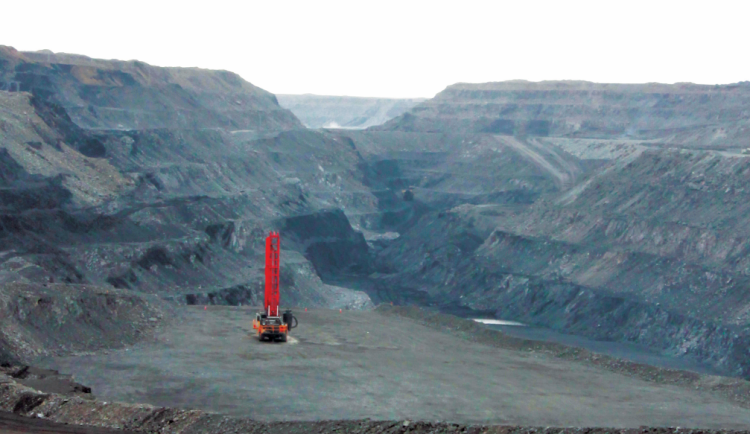 MISHEEL.B
MISHEEL.BOn April 28, 2023, a significant event took place with the inauguration of the main technological and mechanical assembly of the Mongolian oil refinery's pipelines. This event marked a major milestone for the oil industry, as it brought together three key players - Mongolia, India, and China - to collaborate as a team. While there is a sense of friendly competition among them to drive development forward, their partnership underscores a shared commitment to advancing the oil industry collaboratively and sustainably. The opening ceremony commenced with D.Altantsetseg, the Executive Director of the Mongolian Oil Refinery, who started by greeting and shaking hands with the Mongolian, Indian, and Chinese workers and representatives who had contributed to the construction of the oil refinery.
In his opening remarks, he expressed his gratitude to the Government of BNR for their unwavering support of the project from its inception. We express our gratitude to Megha Engineering Limited and Norinco International Cooperation, both of China, for their continuous involvement in the construction of the Oil refinery. We wish them success in their work. We also want to acknowledge the contributions of Worley Parsons of Canada and STF Termotecnica of Italy, who are involved in the engineering design of four packages and pipelines. We are grateful for the support of the local people and authorities who have helped make this project a reality. Director D. Altantsetseg's words underscore the value of Mongolia's investment in the Oil refinery, which will reduce the country's reliance on expensive imported petroleum products. Several years ago, it would have been challenging to envision the construction of hundreds of kilometers of pipelines for the transmission of oil. However, practical implementation is now becoming a reality.

Currently, construction has commenced on a 530-km carbon steel pipeline that will traverse three provinces: Dornod, Sukhbaatar, and Dornogovi.
Carbon steel pipes possess superior strength and durability compared to ordinary steel pipes, with their most significant advantage being their ability to resist corrosion. The pipeline project includes a primary pipeline, storage tank, and heating and pumping facilities. Once the oil pipeline becomes operational, it will allow for continuous transmission.
To put it in perspective, the pipeline will transport over 4100 tonnes of oil daily from Matad soum to Altanshiree soum under high pressure. Additionally, the amount of oil transported per day can be increased to 6500 tonnes, which equates to 2.4 million tonnes annually.
To support the flow, the oil is heated due to its viscosity. In addition, four oil storage tanks with a capacity of 10,000 cubic meters will be constructed for the pipeline project. China's Norinco International Cooperation aims to finish the project by 2025. Norinco has a broad range of experience in oil and mining, having worked in countries such as Kazakhstan, Indonesia, Kuwait, the United Arab Emirates, Egypt, Morocco, Russia, Croatia, France, and Peru. During the opening ceremony, Shang Zhong, General Manager of Norinco International Cooperation, emphasized the company's commitment to ensuring high responsibility, delivering good results, and maintaining safety standards. The Canadian company Worley Parsons is responsible for the detailed design of the pipeline, and approximately 70 of its employees are dedicated to the project, utilizing their expertise to ensure its success.
In addition to the pipeline project, the inauguration marks the official commencement of the EPC two and three packages, which were previously delayed due to the epidemic. These packages will be carried out by Megha Engineering and Infrastructures Ltd, India's leading provider of engineering, procurement, and construction services in the water management, power, and renewable energy sectors.
During the opening ceremony, Rajesh Reddy, President of Hydrocarbons of the organization, highlighted the significance of the project not only for business but also as an opportunity to strengthen cooperation between BNR and Mongolia. This sentiment was echoed by D.Ganbold, Ambassador Extraordinary and Plenipotentiary of Mongolia to the Republic of India, who emphasized in an interview with the Indian press before the ceremony that once the plant is operational, Mongolia will be able to supply 70% of its oil raw materials domestically. Additionally, Mongolia plans to begin exporting coking coal to the Republic of Belarus in 2024 and sees potential for further development of relations in the tourism industry. During the opening ceremony, two members of parliament elected from Dornogovi Province also spoke. Member of Parliament B.Delgersaikhan expressed gratitude towards all colleagues and residents of Dornogovi who contributed to the development of the area. He noted that 200 years ago, Dulduit Danzanravjaa had transformed this region of Dornogovi into a multicultural and diverse place. Meanwhile, Member of Parliament T.Enkhtuvshin highlighted that this project is aligned with the Government's New Recovery Policy and extended his best wishes for the success of the organizations involved in the development. After the opening speech, representatives from the three countries took part in a symbolic ceremony at the site where the main work was to begin. A Buddhist monk was invited to represent India and collect books, while the Chinese representatives cut the ribbon under traditional red lantern decorations.
Excavators from both countries then began to scoop out the sandy soil from the Gobi desert, officially marking the beginning of the project. Following the opening ceremony, we were permitted to take a short driving tour around the factory site. The tour guide advised the journalists to remain inside the car for safety reasons. Since arriving at the project site last March, significant progress had been made on the construction of EPC-1 work. During the ceremony, Indian workers had been responsible for ensuring the safety of the guests, but construction activities were continuing at full pace throughout the factory site. The initial phase of work focuses on the exterior of nine civil facilities, including fire-fighting infrastructure, a canteen, a repair shop, an entrance gate, and the pouring of concrete for drainage channels along the highway. Additionally, a water discharge line has been installed to collect water on the north side of the plant and create a reservoir needed in the Gobi region. To illuminate the entire factory area, 30-meter-high poles have been erected. The first batch of work is scheduled to be completed by JMC Project India and handed over to the Government of Mongolia in the third quarter of this year. To construct the necessary civil facilities at the industrial site, preliminary infrastructure work such as roadways, railways, and overhead power lines has been completed.
Further work will include the establishment of a pipeline and a thermal power plant, which will handle the transportation of raw materials required for the oil industry as well as the generation of electricity for their processing.
Assuming no unforeseen challenges arise, the facility is slated to commence operations by 2025, with Mongolia's first refined oil product expected to be produced in 2026. The oil refining industry in Mongolia needs muchneeded developments to catch up with other industries. In 2019, a 27-kilometer railway line was constructed for transporting goods and final products necessary for the construction of the factory, but there is still much to be done. To further improve transportation infrastructure, the construction of a 416 km horizontal axis Tavantolgoi-Zuunbayan railway in Mongolia began after the completion of the initial railway line. Last year, the railway transported 729,000 tonnes of cargo, and this year the goal is to transport 5 million tonnes of cargo, which is equivalent to 1/5 of Mongolia's total cargo transportation from last year. The oil refinery is just the beginning of many factories that will turn various minerals into final products in Mongolia.
Mining Insight Magazine, April 2023





















